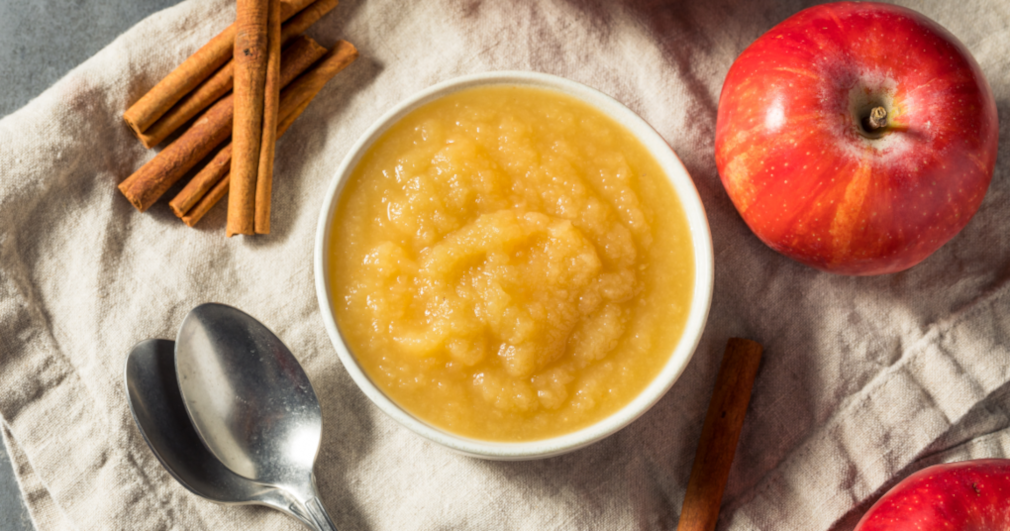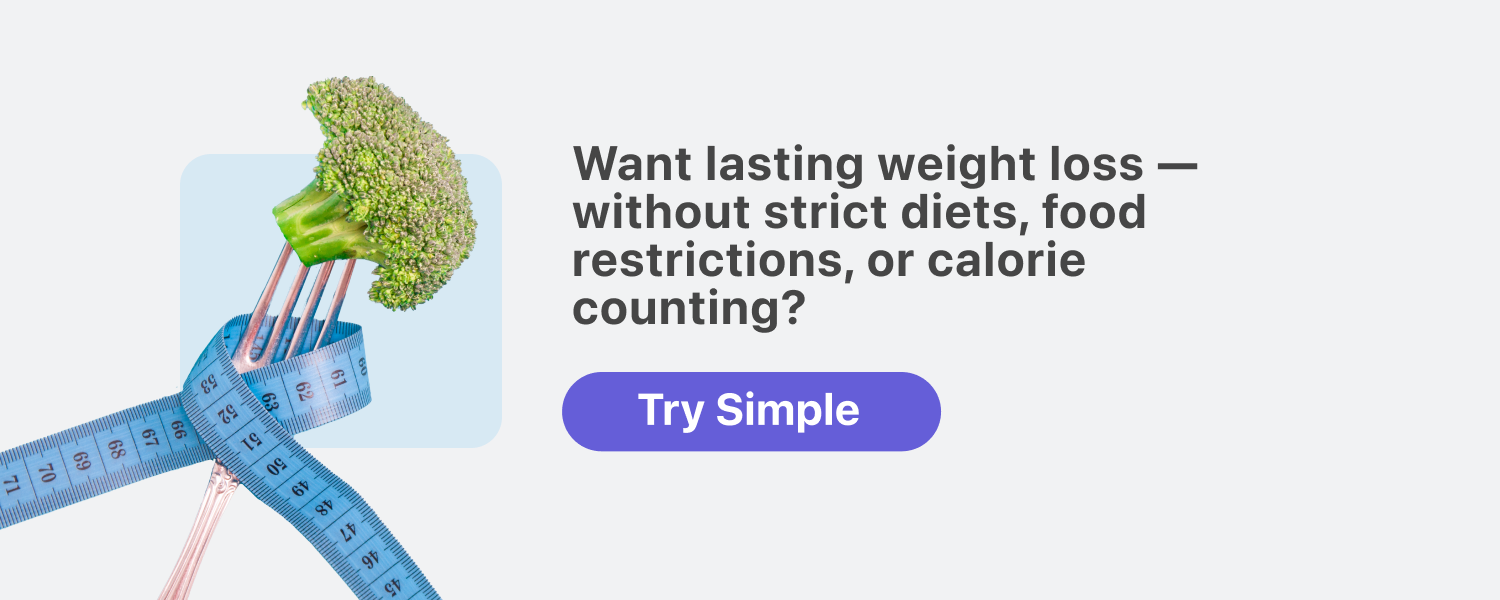Is applesauce good for you? — Health benefits and nutrition explained

Apples have been around for a long time. Some evidence suggests that large fruits with seeds appeared over 2 million years ago — a tasty snack for the prehistoric animals who would then spread those seeds far and wide.[1]

Now, modern-day animals like us also enjoy apples as a tasty snack. Although an apple a day probably won’t completely keep the doctor away, apples are chock-full of beneficial nutrients that can improve your health when incorporated into a balanced and healthy lifestyle.[2,3,4]
Whether you’re on the run or just need a quick snack at home, apples can be an excellent choice. They’re portable and nutritious; plus, they have a durable wrapper with its own nutritional gifts like antioxidants (e.g., quercetin in red apples) and fiber.
Since apples are so nutritious, you might be wondering if applesauce is as well. Read on to find out if applesauce is just as healthy as the original!
What’s applesauce?
Applesauce is simple — in its purest form, it’s nothing but cooked apples. Typically, the apples are peeled, cored, and softened (either by boiling or baking), then mashed, pressed through a mesh sieve, or pureed. The result is a sweet, delicious sauce!
Consistency varies depending on which technique you use. You may prefer the smoother, puréed version or the chunkier result of light mashing.
Depending on taste preference and the variety of apples you use to make the sauce, you may or may not need to add other ingredients. Typically, you’d add sugar if tart apples were the main ingredient. It’s common to add cinnamon since it adds a nice color and an added layer of sweetness. You can add lemon juice or ascorbic acid to make it tarter, stop the applesauce from turning brown, and increase its shelf-life.
Recorded recipes for applesauce date as far back as the medieval period in Europe, from as early as 1390. But applesauce has likely been around for much longer!

Applesauce nutrition
Healthy carbohydrates
Apples are a mix of carbohydrates, including the sugars that make them sweet and the fiber that gives them their structure. In particular, apples are typically higher in pectin, a type of fiber that forms a gel during digestion and has potential health benefits like lowering cholesterol.[5]
Vitamin C and antioxidants
Apples are also a good source of vitamin C and other antioxidants. The more processed applesauce is, the more nutrients it will lose. Despite losing nutrients during processing, a serving of applesauce is still an excellent fiber and vitamin C source – providing 12% and 7% of your daily needs, respectively.[6,7]
Nutrition varies by ingredients
Applesauce nutrition changes dramatically depending on which ingredients you use.
- If the apple skin remains, fiber and antioxidant content go up.
- If you add sugar, calories go up.
Store-bought applesauce sometimes has other ingredients like high fructose corn syrup or other fruits, each of which affects the sauce’s nutritional content. High-fructose corn syrup can be less-than-ideal for your health, so always be sure to read the label when you buy applesauce from the store.
Curious about how applesauce and your other favorite snacks stack up nutritionally? Check out Simple’s Nutrition Scores to see how your choices measure up. Get started today by taking our Simple quiz.
Does applesauce have health benefits?

Applesauce can be a terrific addition to your healthy and balanced lifestyle as long as you eat it in moderation.
Let’s look at some of the small ways this modest food can help support good health.
- Tissue repair: Vitamin C is a key part of healing wounds.[8] Foods rich in vitamin C (ascorbic acid) can support each step of the wound healing process, from the initial inflammatory phase through scar formation. However, the vitamin C content of a fresh apple will be higher than that of applesauce, so you may want to consider eating the fruit in its natural form to get the most bang for your nutritional buck.
- Diabetes prevention: Studies show there may be a link between apple consumption and a decreased risk for type 2 diabetes. But again, research suggests we might get the most benefits from whole fruit.[9,10] From a nutritional standpoint, it’s best to leave the skin on your apples!
- Heart health: The antioxidants and fiber that apples contain can prevent vascular damage from free radicals and lower your cholesterol.[11] Consuming lots of fruits and vegetables is linked to a lower risk of cardiovascular diseases like heart attacks and strokes. But again … it works best when you eat the whole fresh apple.
- Weight control: The fiber and water content in applesauce helps you feel full longer than other prepackaged or sweet snacks might.[12] Pair applesauce with nuts or mix in some chia seeds, and you’ve got a snack that’ll keep you satisfied for several hours.
- Baking substitute: Applesauce can replace fat in many baked goods like muffins. If you use applesauce as a substitute, you’ll have more fiber and vitamins in your goodies. Because applesauce tends to be sweet, it’s a terrific way to reduce the sugar in your baked goods.
A few things to keep in mind
All around, applesauce — especially if it’s homemade and low in added sugar — is a healthy snack, side dish, or baking substitute. But there are some things to pay attention to with this lovely treat.
Some store-bought applesauce variations might have a lot of added sugar. That not only increases the amount of calories you consume, but over time, this can impact your blood sugar levels, especially if you have a higher risk of or a current diagnosis of diabetes.
Other ingredients like preservatives and high-fructose corn syrup may not be ideal for your health to consume in large quantities.[13] If you have diabetes or are at risk, these applesauce variations may not be best for you.
Typically, store-bought applesauce doesn’t include the peels, so many nutrients are left out.
How to make applesauce
If the thought of leaving those nutrients on the table has you saying, “Applesolutely not,” why not try making it yourself? It’s super simple to make homemade applesauce with the peel; all you’ll need are apples and water.
- Core and quarter two large apples.
- Add the apples to a small saucepan and pour in 2 to 4 tbsp. of water.
- Cover and cook the apples over medium heat until the water simmers and the apples lose their shape.
- Remove the apples from the stove, allow them to cool for a minute or two, and then blend them. You can use an immersion blender, a standard blender, or a food processor. If you use a food processor, you may want to pour the mixture through a sieve to remove the larger skin chunks.
This recipe makes about two ½ cup servings. Enjoy it warm, or keep it in the fridge and eat it cold. It’ll keep for up to seven days in the fridge.
You can also add a dash of cinnamon to get that nutty flavor and add a couple of splashes of lemon juice after it’s blended to get some more vitamin C and help the color last longer. If there’s a bit of sweetness missing, you can add some natural sweeteners like stevia. The sky’s the limit on how you can customize the recipe to your taste!
(BTW, if you loved the homemade applesauce recipe, there’s more where that came from! Get more delightful and nutritious recipes tailored just for you through the Simple app. Take our quiz and get started today.)
Applesauce nutrition can vary depending on the ingredients used.
For example, if you leave the apple skin on, the fiber and antioxidant content increase, making it a healthier choice. However, if you add sugar to sweeten it, the calorie count goes up.
Additionally, store-bought applesauce may contain other ingredients like high fructose corn syrup or additional fruits, each of which can affect the sauce’s nutritional content. Make sure to read the label when purchasing store-bought applesauce.

- Spengler RN. Origins of the Apple: The role of megafaunal mutualism in the domestication of Malus and Rosaceous trees. Front Plant Sci. 2019 May 27;10:617.
- Hyson DA. A comprehensive review of apples and apple components and their relationship to human health. Adv Nutr. 2011 Sep;2(5):408–20.
- Boyer J, Liu RH. Apple phytochemicals and their health benefits. Nutr J. 2004 May 12;3:5.
- Kalinowska M, Bielawska A, Lewandowska-Siwkiewicz H, Priebe W, Lewandowski W. Apples: Content of phenolic compounds vs. variety, part of apple and cultivation model, extraction of phenolic compounds, biological properties. Plant Physiol Biochem. 2014 Nov;84:169–88.
- Bostancı NS, Büyüksungur S, Hasirci N, Tezcaner A. Potential of pectin for biomedical applications: A comprehensive review. J Biomater Sci Polym Ed. 2022 Oct;33(14):1866–900.
- CDC. Fiber: The carb that helps you manage diabetes [Internet]. Centers for Disease Control and Prevention. 2022 [cited 2023 Sep 18]. Available from: https://www.cdc.gov/diabetes/library/features/role-of-fiber.html
- National Institute of Health Nutrition Factsheets: Vitamin C [Internet]. [cited 2023 Sep 18]. Available from: https://ods.od.nih.gov/factsheets/VitaminC-HealthProfessional/
- Moores J. Vitamin C: A wound healing perspective. Br J Community Nurs. 2013 Dec;Suppl:S6, S8–11.
- Song Y, Manson JE, Buring JE, Sesso HD, Liu S. Associations of dietary flavonoids with risk of type 2 diabetes, and markers of insulin resistance and systemic inflammation in women: A prospective study and cross-sectional analysis. J Am Coll Nutr. 2005 Oct;24(5):376–84.
- Muraki I, Imamura F, Manson JE, Hu FB, Willett WC, van Dam RM, et al. Fruit consumption and risk of type 2 diabetes: Results from three prospective longitudinal cohort studies. BMJ. 2013 Aug 28;347:f5001.
- Kim SJ, Anh NH, Jung CW, Long NP, Park S, Cho YH, et al. Metabolic and cardiovascular benefits of apple and apple-derived products: A systematic review and meta-analysis of randomized controlled trials. Front Nutr. 2022 Apr 5;9:766155.
- Jovanovski E, Mazhar N, Komishon A, Khayyat R, Li D, Blanco Mejia S, et al. Can dietary viscous fiber affect body weight independently of an energy-restrictive diet? A systematic review and meta-analysis of randomized controlled trials. Am J Clin Nutr. 2020 Feb 1;111(2):471–85.
- Meyers AM, Mourra D, Beeler JA. High fructose corn syrup induces metabolic dysregulation and altered dopamine signaling in the absence of obesity. PLoS One. 2017 Dec 29;12(12):e0190206.
